As a kayaking enthusiast, I understand the importance of having the right equipment to make your experience on the water even more enjoyable. One such essential piece of gear is a kayak cart. If you’re wondering how to use a kayak cart, you’ve come to the right place. In this guide, I’ll break down the basics of using a kayak cart to help you transport your kayak with ease.
Before we dive into the process, let me quickly explain what a kayak cart is all about. It’s a handy tool designed to make it simpler for you to carry your kayak from your vehicle to the water’s edge, saving you time and effort. With a well-built cart, the days of struggling to find a comfortable grip on your kayak as you lug it awkwardly across the ground will be behind you.
To get started with your kayak cart, first, ensure that the cart is assembled and ready for use. This usually involves attaching the wheels and setting up the cart’s support frame. Next, position the kayak on top of the cart, making sure it’s stable and secure. Once the kayak is properly situated, use the cart’s straps to fasten the kayak in place, and you’ll be ready to roll.
Remember, your goal is to find the perfect balance between security and ease of transport, so be sure to adjust the straps and cart as needed.
Contents
Contents
Understanding Kayak Carts
A kayak cart is an essential piece of equipment that makes the process easier and more efficient. In this section, I’ll explain how to use a kayak cart and provide some helpful tips to ensure a smooth experience.
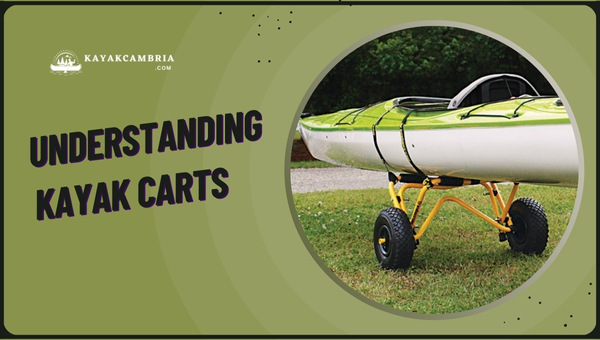
A kayak cart is a wheeled device designed to help you transport your kayak from your vehicle to the water’s edge without causing any damage to the hull or your back. These carts come in a variety of styles and sizes, each with its unique features and advantages. Here are some of the most common types of kayak carts:
1. Folding Carts
These carts fold up when not in use, making them easy to store and transport. They typically have a lightweight frame and medium-sized wheels.
2. Fixed-Frame Carts
These carts have a more rigid structure and tend to be more durable. They usually have larger wheels, making them suitable for navigating rough terrain.
3. End Carts
These kayak carts attach to the end of the kayak, providing a more balanced and simplified method for moving the kayak.
When using a kayak cart, it’s essential to follow these steps to ensure your kayak transportation runs smoothly:
- Position the cart: Place the cart at the center of your kayak, ensuring the wheels are parallel to the water’s edge. You can adjust the straps or cradles as needed to achieve a secure fit.
- Secure the kayak: It’s crucial to attach the straps provided with the cart, wrapping them around the kayak and tightly securing them to the cart frame. This helps prevent the kayak from slipping or falling off during transportation.
- Transport the kayak: Once the kayak is securely attached to the cart, you can begin moving it. Using one hand to guide the cart and the other to maintain control of your kayak, gently push or pull the cart with your kayak toward the water.
- Unload the kayak: Upon arriving at your destination, carefully remove your kayak from the cart, ensuring the straps are completely released to prevent any damage.
Here are a few more tips to make the most of your kayak cart experience:
- Always check the weight capacity of the cart to ensure it can handle your kayak’s weight.
- Inflate the tires (if applicable) to the proper pressure for a smoother ride.
- Experiment with different positions and attachments to find the best balance and fit for your kayak cart.
By keeping these tips in mind and following the steps on how to use a kayak cart, you’ll enjoy a hassle-free experience that saves you time and energy, allowing you to focus on enjoying your kayak adventures.
Selecting The Right Kayak Cart
Finding the right kayak cart can substantially simplify the process of transporting your kayak to and from the water. It’s important to take into consideration factors like portability, materials, and wheel types before making a decision on which cart to purchase. Here, I’ll provide some useful tips on how to use a kayak cart, as well as guidance on what to look for when choosing the perfect cart for your needs.
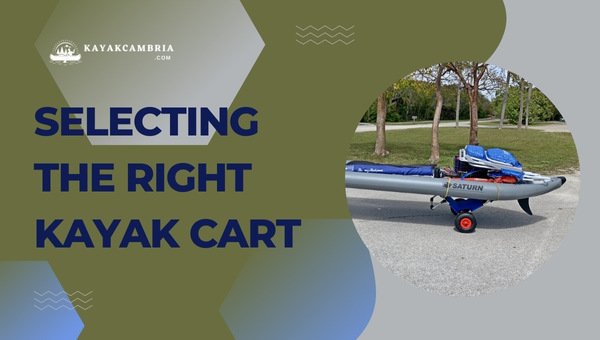
The first thing to consider is portability. Some kayak carts are designed to be more compact and lightweight, while others focus on sturdiness and durability. To determine which kayak cart best matches your needs, think about:
- How often you’ll be transporting your kayak
- The distance from your vehicle to the water
- Whether you plan to travel with your kayak cart
Next, take a closer look at the materials used to construct the cart. The most commonly used materials include:
- Aluminum – lightweight, but may be less durable in the long term
- Stainless steel – heavier than aluminum, yet more resilient and able to withstand harsher conditions
Consider the environment you’ll be using your cart in, as well as your personal durability preferences, when deciding on the right material.
The type of wheels on your kayak cart will also impact its performance. There are three primary wheel types you’ll encounter:
- Solid wheels – maintenance-free, but potentially less smooth on uneven terrain
- Pneumatic tires – air-filled, providing a smoother ride but may require regular maintenance
- Balloon wheels – designed for use on sand and other soft surfaces
Keep in mind the terrain you’ll be traveling over, as well as any specific needs for your kayaking locations when making a decision on wheel type.
When selecting a kayak cart, also consider any additional features that might be important to you, such as:
- Adjustable width – to accommodate different kayak sizes
- Straps and padding – for added security and protection of your kayak
- Foldability – for easier storage and transport
Lastly, price is always a factor to keep in mind. While it’s important to find a kayak cart that fits within your budget, also remember that investing in a high-quality cart can save you money in the long run by providing better durability and performance.
By considering these factors, you should be able to find the perfect kayak cart that not only makes it easy to learn how to use a kayak cart but also enhances your overall kayaking experience.
Setting Up The Kayak Cart
Knowing how to use a kayak cart can greatly simplify your kayaking adventures. I’ll break down the setup process step by step, so you’ll be ready to hit the water in no time.
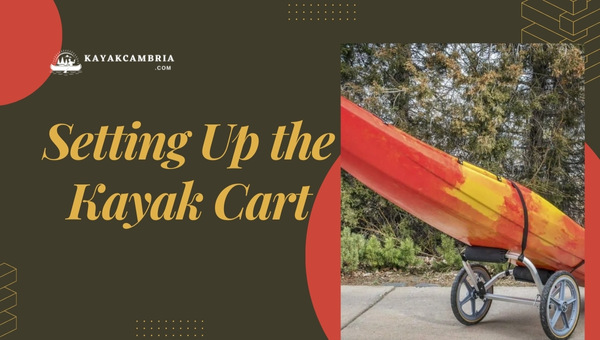
1. Assemble the cart
First, you need to assemble the cart according to the manufacturer’s instructions. Most kayak carts come with:
- Two wheels
- A frame
- Straps
- Axle
Ensure each component is securely fastened and in place to avoid any mishaps during transport.
2. Place the kayak on the cart
Next, gently lift one side of your kayak and slide the cart’s frame underneath it. The kayak should rest on the cart’s pads or supports, with the bulk of the weight balanced evenly. The cart should be placed in a spot where the kayak can be easily maneuvered and won’t be too front- or rear-heavy.
3. Adjust the straps if needed
Most kayak carts come equipped with adjustable straps, which are essential for securing your kayak to the cart. Wrap the strap around your kayak, threading it through the cart’s frame, and tighten it firmly. Make sure there’s enough tension to prevent the kayak from shifting, but not so tight that it damages the kayak’s hull.
4. Check your setup
Before moving your kayak, double-check that it’s resting securely on the cart and the straps are in place. The kayak should be stable and centered on the cart. It’s better to fix any issues now than to risk damaging your kayak during transport.
5. Transport your kayak
Once everything’s in place, grasp the kayak’s handle or grip near the cockpit and begin rolling your cart toward your destination. Remember to use caution when navigating uneven terrain and always keep an eye on your kayak to ensure it’s stable and secured on the cart.
Setting up your kayak cart involves assembling the cart, positioning the kayak on the cart, adjusting and securing the straps, checking your setup, and finally, transporting your kayak. With these straightforward steps, you’ll be well on your way to enjoying a hassle-free kayaking experience.
Loading Your Kayak Onto The Cart
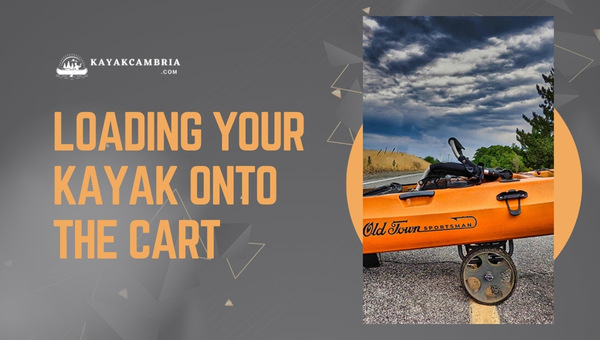
So, you’ve decided to invest in a kayak cart to make transporting your kayak a breeze. Now it’s time to learn how to use a kayak cart effectively. Loading a kayak onto a cart might seem tricky at first, but with a little practice, you’ll become a pro in no time. I’ll walk you through the process in just a few simple steps.
Step 1: Position Your Kayak Cart
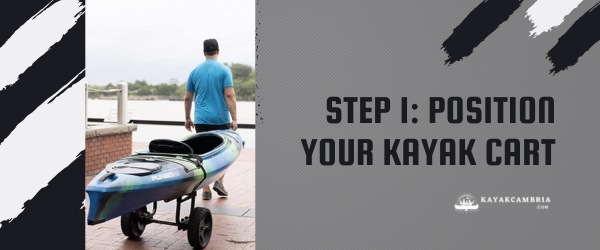
Begin by positioning your kayak cart near the rear end of the kayak. Ensure that the kayak cart’s cradle or pads are close to the kayak’s center of gravity, which is usually around its cockpit area. This will allow for optimal balance and stability while moving the kayak on the cart.
Step 2: Lift the Kayak onto the Cart

Now it’s time to lift your kayak onto the cart. There are two main methods I recommend:
- Solo Lifting: If you’re doing the lifting alone, carefully lift the rear end of your kayak and slide the cart underneath. Make sure the kayak is resting securely on the cart cradle or pads.
- Tandem Lifting: If you have a friend to help, each of you should grab the kayak on either side, near its center. Lift the kayak together and place it evenly onto the cart’s cradle or pads.
Step 3: Secure the Kayak

Once your kayak is on the cart, it’s essential to secure it properly. Here are the common methods:
- Straps: Many kayak carts come with straps that loop around the kayak, then buckle or latch to secure it. Thread the straps through any available attachment points on your cart and tighten them snugly around the kayak.
- Bungee Cords: If your cart doesn’t have straps, you can use bungee cords to secure the kayak. Hook one end of the bungee cord to the cart, wrap it around the kayak, then hook the other end back onto the cart. Always make sure the bungee cords are tight and secure to prevent the kayak from slipping off the cart during transport.
Step 4: Test the Stability
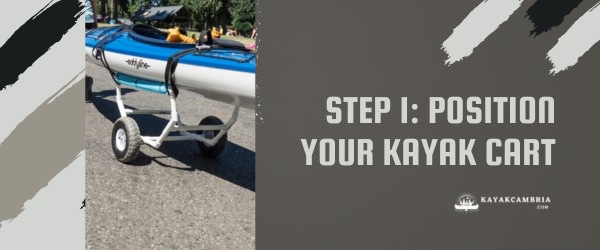
Before you start moving, give your kayak a gentle shake to test its stability on the cart. If it feels stable and secure, you’re ready to go. If not, adjust the kayak’s position on the cart and double-check the straps or bungee cords until you achieve a secure and balanced setup.
There you have it – now you know how to use a kayak cart effectively. Follow these simple steps, and you’ll have no trouble getting your kayak from Point A to Point B with ease. So go on, enjoy your paddling adventures knowing that transporting your kayak is no longer a cumbersome task.
Securing The Kayak To The Cart
Properly securing your kayak to the cart is an essential skill to learn, and it’s not as complicated as it may seem. In this section, I’ll provide you with step-by-step instructions on how to safely and efficiently attach your kayak to a cart, helping you avoid any possible damage or mishaps during transportation. Keep in mind that how to use a kayak cart might slightly vary depending on the type of cart and kayak you own.
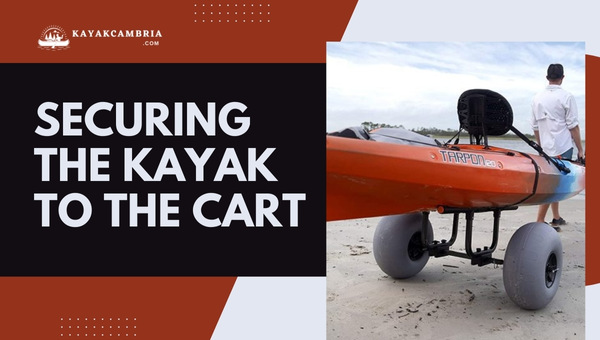
The first thing you should do is position your cart correctly. Place the cart towards the center of the kayak’s gravity to ensure maximum stability. This is usually found right beneath the kayak’s seat or slightly behind it, depending on the kayak’s design.
Once you have the cart in the appropriate position, follow these steps to secure the kayak:
- Use straps or ropes: To secure the kayak to the cart, you’ll need suitable straps or ropes. These should be long enough to wrap around the kayak and cart a few times to create a solid connection. I recommend using ratchet straps or cam buckle straps for the best results, as they are easier to tighten and adjust.
- Thread the straps or ropes through the cart: Take one end of your chosen strap or rope and thread it through the kayak cart’s loop, hole, or any designated anchor points on the cart. If your cart doesn’t have any attachment points, consider looping the strap or rope around the cart’s frame to create an anchor point.
- Loop the straps or ropes around the kayak: Wrap the straps or ropes around the kayak’s body, making sure they are tight and secure. For ratchet straps, connect the two ends and tighten the strap by ratcheting it. For cam buckle straps, feed one end of the strap through the cam buckle and pull it tight. With ropes, use appropriate knots like the truckers hitch or the bowline knot for a secure fit.
- Check for tightness and secure any loose ends: After securing your kayak to the cart, double-check for tightness and adjust as needed. Make sure any loose strap or rope ends are securely fastened, so they don’t interfere with transportation or cause damage to your kayak.
Here are some general tips to keep in mind while securing the kayak to the cart:
- Distribute weight evenly on the cart to ensure a smooth and stable transportation
- Make sure the kayak is centered on the cart to avoid tipping or sliding off during transportation
- Regularly inspect your straps or ropes for wear and tear, and replace them as needed for your safety
By following these guidelines, you’ll have a better understanding of how to use a kayak cart effectively and safely, making your kayaking adventures more enjoyable and stress-free.
Unloading and Storing Your Kayak
So, you’ve finally made it back to shore after a great day on the water. Now comes the challenging part – unloading and storing your kayak properly. In this section, I’ll guide you through how to use a kayak cart and give you some practical tips to make the task more manageable.
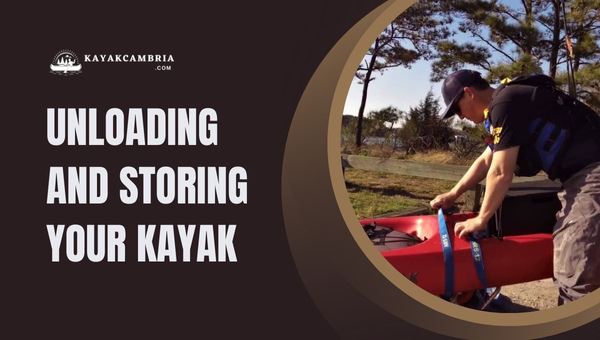
Using a Kayak Cart
- First, position the kayak cart: Place your kayak cart on the ground, somewhere next to your kayak. Make sure it’s on an even surface so it won’t roll away or tip over.
- Then, lift your kayak: Carefully lift your kayak from one end, taking care to use your legs and back to shift the load. This will help avoid any strain or injury.
- Now, slide the cart under: With one end of the kayak lifted, slide the kayak cart under it. It’s important to position the cart towards the center of the kayak, ensuring even weight distribution.
- Adjust and secure the kayak: Adjust your kayak on the cart as needed, and fasten any straps or bungee cords to keep it stable and secure during transport.
With your kayak on the cart, it’s time to move it to your storage location. Remember to always follow safety practices when using a kayak cart, such as not overloading it and inspecting the tires for wear.
Storing Your Kayak
When it comes time to store your kayak, it’s essential to protect it from damage or deformation. Here’s how:
- Choose the right spot: Find a spot that’s sheltered from direct sunlight, heat, and moisture, as these elements can damage your kayak over time.
- Use proper supports: To prevent deformations, use padded supports or sawhorses to evenly distribute the weight of the kayak, particularly on the hull or deck.
- Don’t hang by the grab loops: Avoid hanging your kayak by its grab loops, as this can lead to distorting its shape or even causing damage to the loops.
- Use a cockpit cover: To keep out unwanted pests, debris, and moisture, use a breathable cockpit cover when storing your kayak.
Knowing how to use a kayak cart and properly store your vessel will ensure it’s in top shape for your next adventure. With practice, this process will become second nature, and you’ll be ready for many more enjoyable kayak outings.
Conclusion
At the end of the day, knowing how to use a kayak cart effectively is essential to making your paddling adventures smoother and more enjoyable. After using a kayak cart, I’ve noticed that I can easily transport my kayak with minimal effort, leaving me more energy for the fun part: paddling through nature’s wonders.
Some of the most important points to remember while using a kayak cart are:
- Choosing the right cart for your kayak: Consider factors such as build, design, and weight capacity.
- Loading and securing the kayak: Ensure that the kayak is balanced and well-secured to the cart to avoid any damages or accidents during transportation.
- Proper handling while in motion: When pushing or pulling the cart, pay attention to the terrain and handle it with caution to ensure both your safety and the safety of your kayak.
- Maintenance and storage: Proper maintenance and storage of the cart will not only prolong its life but also prevent potential issues when using it in the future.
Ultimately, by understanding how to use a kayak cart properly, I’ve discovered a convenient solution to the age-old problem of moving a cumbersome kayak from one location to another. This handy piece of gear has transformed my kayaking experiences, allowing me to focus more on the joys of the water and less on the challenges of transporting my kayak.

